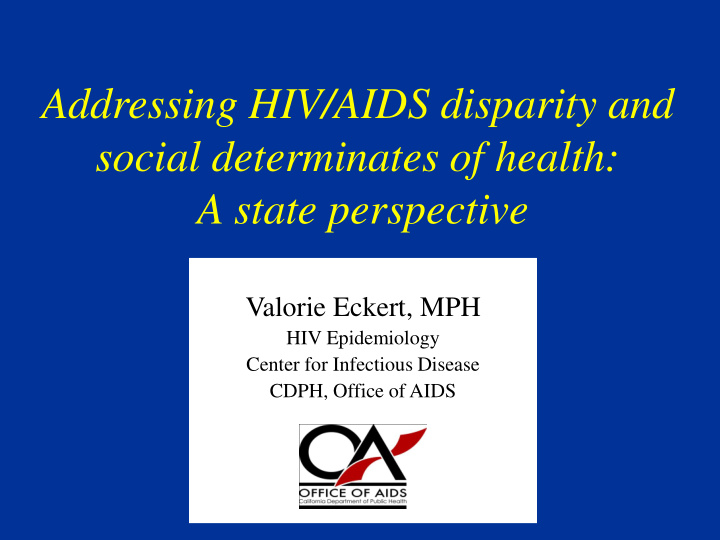



Addressing HIV/AIDS disparity and social determinates of health: A state perspective Valorie Eckert, MPH HIV Epidemiology Center for Infectious Disease CDPH, Office of AIDS
Factors, drivers, and social determinates, oh my! Demographics: 1) Race/ethnicity, gender 2) County/LHJ level Transmission related: 1) Risk group 2) STD prevalence/co-infection 3) Infectiousness (‘late testers’, non - adherence, etc) 4) Social networks Other measures: 1) Poverty/living environment 2) Access to services 3) Quality of care 4) Incarceration Unstable housing/”homelessness” 5)
Trends in new diagnoses
Most dramatic decrease seen among whites, MSM
California HIV Surveillance data (eHARS) Frozen dataset, 2/22/12
Selected Bay Area Counties California HIV Surveillance data (eHARS) Frozen dataset, 2/22/12
Disparity
How does Bay Area compare?
Co-factors/drivers: STDs STD incidence among persons living with HIV/AIDS was highest among males, those aged 20-29 years and those living in SF. Incident gonorrhea is highest among black males, particularly black MSM. Syphilis incidence highest among Asian and Hispanic race/ethnicities. Source: Nicole Olsen , Michael Samuel, et. al. STD and HIV/AIDS Case Registry Matching to Estimate California STD-HIV/AIDS Co-infection, 2009.
A measure of transmission risk and access to services: HIV/AIDS concurrency or “late testing” (i.e. diagnosed with AIDS at the time or within one year of original HIV diagnosis)
Age at diagnosis Race/ethnicity
Emerging a reas of focus • Use of surveillance data needed to evaluate (including National HIV/AIDS Strategy objectives) • Increase electronic lab and case reporting capacity • Use HIV epidemiologic research data to identify critical HIV disparities and to develop novel approaches to reducing these disparities in CA • Geographic presentation and analysis of data
Examples of using existing data to measure linkage to care, treatment and retention in care
NHAS: Goal 3 Indicator: viral load suppression among MSM/Bi, Blacks and Latinos Note: statewide data
ADAP Indicator: CD4 or VL level of clients upon enrollment in ADAP PERCENT CD4 GROUP BY RACE / ETHNICITY FOR NEW ENROLLEES, 2010 AFRICAN HISPANIC / NATIVE AM / PACIFIC MULTI- RACE / WHITE ASIAN UNKNOWN CD4 GROUP AMERICAN LATINO INDIAN ISLANDER ETH TOTAL (N=1650) (N=203) (N=88) (N=821) (1475) (N=7) (N=19) (N=145) Less than 200 16.79% 22.78% 27.80% 23.65% 0.00% 15.79% 24.83% 23.86% 22.28% 201 - 350 17.88% 19.37% 21.49% 26.11% 28.57% 31.58% 19.31% 14.77% 19.80% 351 - 500 19.58% 20.10% 19.80% 20.69% 28.57% 15.79% 17.24% 13.64% 19.60% 501 - 750 22.67% 17.17% 16.75% 20.20% 14.29% 31.58% 24.83% 13.64% 19.46% Greater than 750 12.55% 6.09% 6.44% 3.45% 0.00% 5.26% 11.72% 6.82% 8.69% Invalid date / result 4.67% 5.60% 2.51% 2.46% 28.57% 0.00% 2.07% 1.14% 3.88% Unknown 5.88% 8.89% 5.22% 3.45% 0.00% 0.00% 0.00% 26.14% 6.28% TOTAL 100.00% 100.00% 100.00% 100.00% 100.00% 100.00% 100.00% 100.00% 100.00% PERCENT VL GROUP BY RACE / ETHNICITY FOR NEW ENROLLEES, 2010 AFRICAN HISPANIC / NATIVE AM / PACIFIC MULTI- WHITE ASIAN UNKNOWN VL GROUP AMERICAN LATINO INDIAN ISLANDER RACE / ETH % TOTAL (N=1650) (N=203) (N=88) (N=821) (1475) (N=7) (N=19) (N=145) Undetectable: 200 or less 50.24% 41.05% 40.41% 38.42% 42.86% 47.37% 31.72% 56.82% 44.19% 201 - 5,000 9.52% 11.33% 9.08% 10.84% 0.00% 21.05% 12.41% 9.09% 9.89% 5,001 - 100,000 21.27% 28.75% 29.83% 29.06% 14.29% 26.32% 31.72% 22.73% 26.27% 100,001 - 500,000 13.09% 13.52% 15.19% 16.26% 14.29% 0.00% 17.24% 7.95% 14.00% Greater than 500,000 2.30% 1.46% 3.46% 2.46% 0.00% 5.26% 4.14% 2.27% 2.61% Invalid date / result 3.58% 3.90% 2.03% 2.96% 28.57% 0.00% 2.76% 1.14% 3.04% TOTAL 100.00% 100.00% 100.00% 100.00% 100.00% 100.00% 100.00% 100.00% 100.00% Note: statewide data
Goal: Get clients enrolled and in care earlier (i.e. when T-cells still high)
Geocoding project • Residence at diagnosis • Current residence • Homeless/marginally housed • Correctional populations • IDU networks • Undocumented/migrant workers/day laborers?
Location, location, location…
Other data sources • ARIES data (Ryan White) – Unmet need • Counseling &Testing data – Proposing new ways to link to EHARS & ARIES – Expanded testing grant – Rapid tests and new testing strategies • Medical Monitoring Project (MMP) – Care measures • Nat’l HIV/AIDS Behavioral Surveillance (NHSB) – Indicators of risk – Expanded testing – Mapping opportunities
• Health Disparities Framework – “commitment” to use all resources at hand to eliminate disparities in HIV/AIDS – sustainable • Population profiles: Burden of disease and allocation of resources • Minority AIDS Initiative • Insurance assistance programs
Contact Information Valorie Eckert, MPH HIV Epidemiology Phone: (916) 449-5820 Valorie.eckert@cdph.ca.gov For more HIV Information and Statistics : http://www.cdph.ca.gov/programs/ aids/Pages/Default.aspx
Recommend
More recommend